In 1979 Harriet and I went to Fraser Island for week in our two wheel drive truck ….. see the photo below. You can get to Fraser Island from River Heads (20 minutes south of Hervey Bay). We had on the truck a 44 gallon petrol drum part filled with petrol ….. seeing we would be on this large sand island for a week. I could just siphon new petrol into the truck tank as we needed it.
We had to be very careful in our driving as we were only two wheel driving and not four wheel driving. From River Heads we didn’t cut diagonally across the loose four wheel drive track to the 100 km. long eastern beach going right up to Indian Head. We went around at low tide on the wide exposed beach of the southern tip of Fraser Island. We kept going till we met the long eastern beach. We had many wonderful experiences over the next week ….. some of which are illustrated below in the photographs:
- Ken Fishing ….. there were plenty of pippies at low tide and wonderful bream for catching
- The feeling of driving for kilometre after kilometre along the sandy beach with the ocean on the side …. On the right hand side going up or on the left hand side going back
- We stopped off and explored the ship wreck …. the Maheno
_________________________________________________________________________
Fraser Island Overview:
From: http://www.discoverherveybay.com/FraserIsland/
Fraser Island, off Australia’s eastern Queensland coast, is the world’s largest sand island, stretching over 120km. Panoramic viewpoints include Indian Head, a rocky outcrop on the island’s easternmost tip, and the Cathedrals, a cliff famous for sculpted ribbons of coloured sand. It’s a camping and ecotourism destination, with beaches and swimming sites at Lake McKenzie, Lake Wabby and other freshwater pools.
Fraser Island is a unique part of the Fraser Coast region, and its unusual formation of sand and rainforest make it a special source of adventure for visitors to explore.
Although well known among fisherman and 4WD enthusiasts, it is the history and Aboriginal heritage that gives Fraser Island its individual character, expressed through wonderful coloured sand cliffs, unique fresh water lakes and diverse flora and wildlife.
_________________________________________________________________________
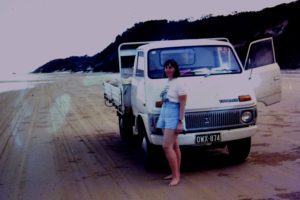
Access to Fraser in our two wheel drive truck …. The tides were low and the beach was wide and hard and once you gained access to the beach, it was easy to drive on it.
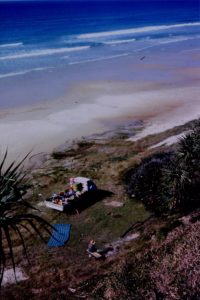
We would drive across the soft sand and make camp with a tarp set up in some trees.The above photo is looking down on one of our camps from high up on top of the grassed sand dune.
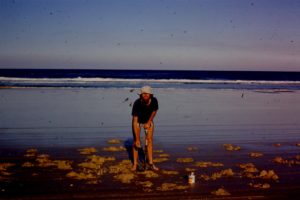
….. There plenty of pippies for fishing if you dug in the soft sand at low tide ….
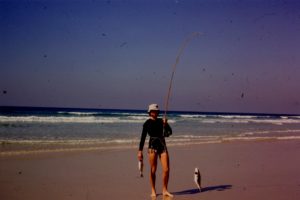
…. Ken catching some big bream at the turn of the tide ……
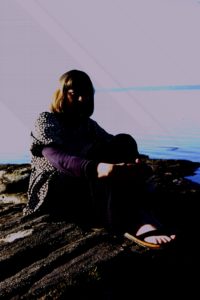
…. Harriet resting on some rock at Indian Head ……
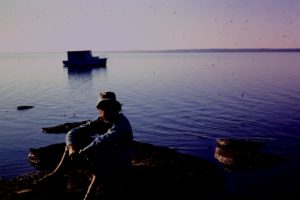
…. Ken resting on some rock at Indian Head ……
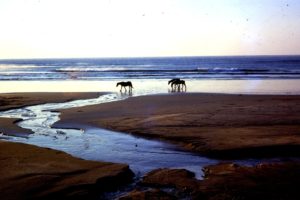
…. Wild horses on the beach early in the morning ……
…. They were possibly drinking the fresh water in the stream flowing out from the main sand dune. There were lots of little streams flowing like this from River Heads to Indian Head ….. this is equal to about 100 kms of beach.
_________________________________________________________________________
The Maheno
SS Maheno was an ocean liner belonging to the Union Company of New Zealand that operated in the Tasman Sea, crossing between New Zealand and Australia, from 1905 until 1935. She was also used as a hospital ship by the New Zealand Naval Forces during World War I. She was washed ashore on Fraser Island by a cyclone in 1935 where the disintegrating wreck remains as a popular tourist attraction.
On 3 July 1935 the Maheno left Sydney under tow by the 1,758 ton ship Oonah, a former Tasmanian Steamers Pty. Ltd. Bass Strait ferry, built in 1888, which along with the Maheno had been sold to an Osaka shipbreaker The ships were linked by a 900-foot (270 m) 6.75-inch (17.1 cm) wire rope.
On the afternoon of 7 July while about 50 miles from the coast, the towline parted during a severe cyclone. Attempts to reattach the towline failed in the heavy seas, and the Maheno, with eight men aboard, drifted off and disappeared. The Oonah, with her steering gear temporarily disabled, broadcast a radio message requesting assistance for the Maheno, whose propellers had been removed.
The ship was finally found on 10 July by an aircraft piloted by Keith Virtue, beached off the coast of Fraser Island. The crew of the Maheno set up camp onshore, waiting for the Oonah to arrive, which it eventually did on 12 July. The ship was subsequently stripped of her fittings, but attempts to refloat her failed, and eventually the wreck was offered for sale, but found no buyers.
Since then, much of the ship has either been destroyed or disintegrated, and the visible remainder has become severely rusted. Because of the dangerous condition of the wreck, access is prohibited. The Australian Department of Defence lists the wreck as a site of unexploded ordnance (UXO) contamination, even though there are no records of it being used as a live firing target during World War II, nor of any UXO recovered from the site.
From https://en.wikipedia.org/wiki/SS_Maheno
_________________________________________________________________________
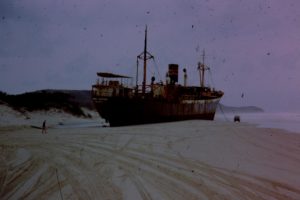
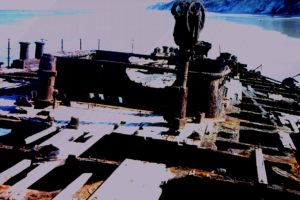
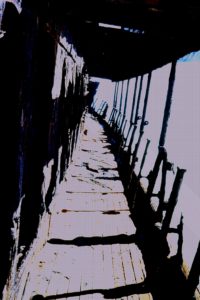
__________________________________________________________________________________
Coming Home …. A week later
We were returning to River Heads to an assigned and paid for time slot on the barge by 3.00 pm. in the afternoon and we came to some rocks …. Poyungan Rocks. When we came up a week ago, the tide was right out and we could easily pass on dry hard sand between the rocks and the coastal sand dune. See the website of Poyungan Rocks: <a href=”http://panedia.com/content/3216″><strong>http://panedia.com/content/3216</strong></a> Watch the 4 ++ YouTube videos on this website …. very current compared to 1979 when we were there.
It was here that I was in trouble. The track went forward and down to the other side of Poyungan Rocks and we would be on our way to the 3.00 pm. barge. However, going over the dune was a major problem. To the right was very loose windblown sand. My heart was in my mouth. If I kept going forward it was OK. If however the truck was caught in the loose sand, it could keep sliding down in the loose sand to bottom of the dune and I would loose the vehicle completely. There were no four wheel drives that could pull us out coming through at that time. I was on my own.
I kept cautiously going forward and finally I was going forward downhill ….. I was through !! We kept on going down the beach towards the western turn around to the barge. My heart was again my mouth. Because of the tide coming in, I had to keep high up on the beach. If I went to high, I would bog in the loose sand and if I went to low, I would bog in the wet sand. I would then be surrounded by water which would finally encase the truck and I never get out. I would loose the vehicle completely in the wet sand.
I drove very carefully with a periodic looking out my open window at the front tyre on my side. I kept watching tyre and the wet sand interface. When I moved closer to the tide, the sand would become very wet and if I moved higher up, I would get into the loose sand with potential danger of bogging. I finally rounded the western corner and the beach changed dramatically. There was no surf and the beach was slightly inclined with a solid surface!
We made the barge in time and got back safely to the mainland ……. was I relieved !!
___________________________________________________________________________
